How To Change Elements Of 2d Vector To Zero Matlab

Introduction to Matlab zeros()
The Matlab inbuilt method zeros() creates array containing all element as zero or empty value. This function allows user an empty assortment having a bunch of zeros in it. The Matlab programming language does not contain whatsoever dimension statement. In Matlab, storage allotment for matrices happens automatically. In instance of large matrices, Matlab programs execution tin be faster by means of the zeros function being used to keep storage for a matrix aside, which elements or a row or column are meant to be created 1 at a fourth dimension.
Syntax of Matlab zeros()
Given beneath are the syntax :
| Syntax | Clarification |
| Z = zeros | This grade of syntax returns an empty scalar i.e. a scalar having value 0 and the output is stored in the variable 'Z'. |
| Z = zeros(n) | This form of syntax returns a matrix containing all elements as zeros of size nXn and the output is stored in the variable 'Z'. |
| Ten = zeros(sz1,…,szN) | This form of syntax returns a matrix containing all elements equally zeros having dimensions of size sz1,…,szN and the output is stored in the variable 'Z'. |
| Ten = zeros(sz) | This class of syntax returns an assortment containing all elements every bit zeros the output is stored in the variable 'Z' of size 'sz'. |
| X = zeros(___,typename) | This form of syntax returns an assortment containing all elements every bit zeros supported by the information type 'typename'. |
| X = zeros(___,'similar',p) | This course of syntax returns an array containing all elements as zeros like the reference matrix p. The zippo matrix should match the matrix p with respect to the same data type or class, complexity i.e real or complex values and sparsity. zeros() role tin support typename or 'like' in a single control but not both together. |
Input Arguments:
- N: Defines the size of the output matrix Z. It supports integer data blazon.
Notation: If value of northward is 0, then the function results in Z being an empty matrix. If value of due north is a negative integer, then zeros() functions treats it every bit '0'.
- sz1,…,szN: Defines the size of each dimension for the output matrix Z. It supports integer data type.
Note: If value of north is 0, then the part results in Z beingness an empty matrix. If value of n is a negative integer, then zeros() functions treats it as '0'. Abaft dimensions i.e. dimensions after the second dimension, are ignored with a size of 1.
- typename: Defines the Information blazon or class for the output matrix Z to create with. Typename tin can be specified as'uint64′, 'double', 'uint8′, 'int32', 'uint32', 'int64', 'single','int8′, 'int16', 'uint16', 'logical'or the name of another class that provides zeros back up.
- p: The reference assortment with which the resultant matrix or assortment should resemble in terms of information type or class, complexity i.e. real or complex values and sparsity.
Examples of Matlab zeros()
Given below are the examples mentioned :
Case #1
The below command generate a scalar variable M having value '0'.
Code:
G = zeros
Output:
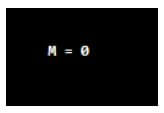
Example #ii
The below set up of control is written to generate nada matrix of given size.
Code:
M1 = zeros(3)
M2= zeros(4)
Output:
The above code generates M1 matrix having all elements of 0 value each of size iii×3 and M2 matrix having all elements of 0 value each of size iv×4.
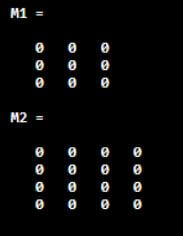
Case #three
The beneath set of control is written to generate 3 dimensional assortment of zeros.
Code:
M = zeros(3,4,5)
size(1000)
Output:
The in a higher place code generates 3 dimensional matrix of zeros having sizes for all 3 dimensions every bit 3,4 and 5 respectively.
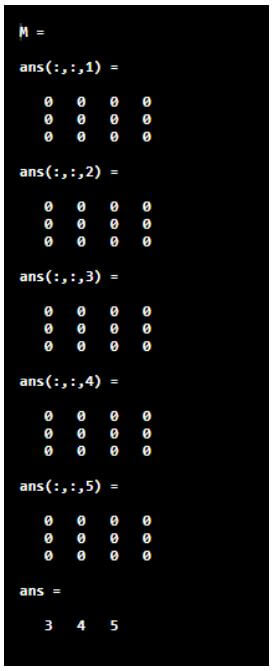
Example #4
The below code generates 2 dimensional nada matrix 'Grand' having size two and 3 respectively and supported past the data blazon 'uint32'.
Lawmaking:
1000 = zeros(2,3,'uint32')
class(M) %Brandish the datatype of the matrix M
Output:
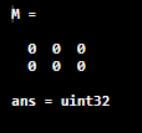
Cloning Size Parameter from Input Argument Assortment
Zeros() method supports creating nada matrix of size same as that of an existing matrix. The below code is written to generate zero matrix of size aforementioned as the existing matrix M_ip.
Lawmaking:
M_ip = [1 four; 2 v; 3 half dozen];
sz = size(M_ip);
Yard = zeros(sz)
G = zeros(size(M_ip));
Output:
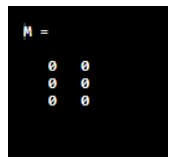
Cloning Complication Parameter from Input Statement Array
zeros() tin can create zero matrix depending on the complexity incorporated in the matrix given as input argument. The below set of command results in the zippo matrix Z having complication level aforementioned as that of the input argument matrix 'compl' i.eastward. of the form of existent + i*imaginary.
Code:
compl = [two+5i 13i];
Z = zeros('like', compl)
Output:

Cloning Sparsity Parameter from Input Argument Array
In terms of scientific computing and numerical analysis, a sparse matrix or an assortment is defined as a matrix or the array in which more than than half of the elements are zero. Hence sparsity of a matrix is defined as the amount of zeros present in the matrix. zeros() can adopt the sparsity of the input matrix to the output matrix every bit shown in the below example.
Instance:
The below example results in output cipher matrix Z adopting the sparsity of the matrix sp.
Code:
sp = sparse(7,7,pi)
Z = zeros(ii,3,'like',sp)
Output:

Cloning Size and Data Blazon Attributes from Input Argument Array
zeros() can create cypher matrix depending on the size and data blazon incorporated in the matrix given as input argument.
Instance:
The beneath case results in output zero matrix Z adopting the size and data type of the matrix uM.
Lawmaking:
uM = uint8([eleven 23 50; 22 14 6]);
Z = zeros(size(uM),'like',uM)
class(Z)
Output:
The resultant output matrix is of size 2×three and data type of unit 8 i.e aforementioned equally the input matrix.
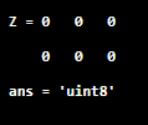
Additional Note:
The zeros()method is very piece of cake to impliment. If 2 values are given equally input argument, it forms matrix in rows by cols format. If either of rows or cols is unity, it results in an assortment. When more than than ii values are used as input argument to zeros() functional telephone call, it results matrix of size defined by the arguments.
There are two situations where this functionality plays major role:
- When user needs to create a list of counters, having counting initial value as zero.
- When the program requires a large assortment to be created having pre-allocated reserved memory.
Recommended Articles
This is a guide to Matlab zeros(). Here we discuss the introduction, examples, cloning size, cloning complexity and sparsity parameter from input argument array, and cloning size and data type attributes from input statement array. You may likewise take a wait at the following articles to learn more than –
- MATLAB Unique
- Matlab Plot Legend
- xlsread Matlab
- Fourier Serial Matlab
Source: https://www.educba.com/matlab-zeros/
Posted by: hardinghort1989.blogspot.com


0 Response to "How To Change Elements Of 2d Vector To Zero Matlab"
Post a Comment